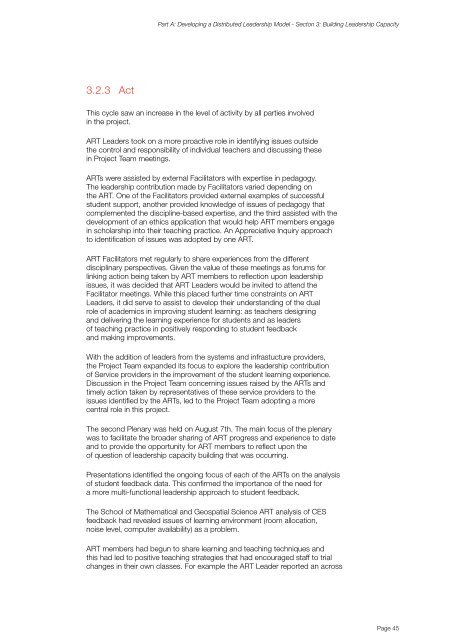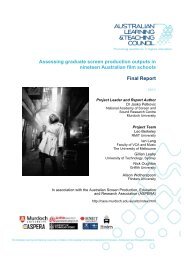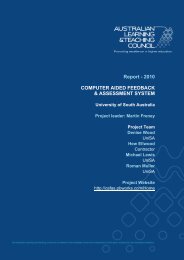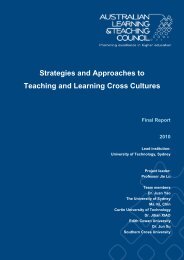student feedback and leadership - Office for Learning and Teaching
student feedback and leadership - Office for Learning and Teaching
student feedback and leadership - Office for Learning and Teaching
You also want an ePaper? Increase the reach of your titles
YUMPU automatically turns print PDFs into web optimized ePapers that Google loves.
Part A: Developing a Distributed Leadership Model - Secton 3: Building Leadership Capacity3.2.3 ActThis cycle saw an increase in the level of activity by all parties involvedin the project.ART Leaders took on a more proactive role in identifying issues outsidethe control <strong>and</strong> responsibility of individual teachers <strong>and</strong> discussing thesein Project Team meetings.ARTs were assisted by external Facilitators with expertise in pedagogy.The <strong>leadership</strong> contribution made by Facilitators varied depending onthe ART. One of the Facilitators provided external examples of successful<strong>student</strong> support, another provided knowledge of issues of pedagogy thatcomplemented the discipline-based expertise, <strong>and</strong> the third assisted with thedevelopment of an ethics application that would help ART members engagein scholarship into their teaching practice. An Appreciative Inquiry approachto identification of issues was adopted by one ART.ART Facilitators met regularly to share experiences from the differentdisciplinary perspectives. Given the value of these meetings as <strong>for</strong>ums <strong>for</strong>linking action being taken by ART members to reflection upon <strong>leadership</strong>issues, it was decided that ART Leaders would be invited to attend theFacilitator meetings. While this placed further time constraints on ARTLeaders, it did serve to assist to develop their underst<strong>and</strong>ing of the dualrole of academics in improving <strong>student</strong> learning: as teachers designing<strong>and</strong> delivering the learning experience <strong>for</strong> <strong>student</strong>s <strong>and</strong> as leadersof teaching practice in positively responding to <strong>student</strong> <strong>feedback</strong><strong>and</strong> making improvements.With the addition of leaders from the systems <strong>and</strong> infrastucture providers,the Project Team exp<strong>and</strong>ed its focus to explore the <strong>leadership</strong> contributionof Service providers in the improvement of the <strong>student</strong> learning experience.Discussion in the Project Team concerning issues raised by the ARTs <strong>and</strong>timely action taken by representatives of these service providers to theissues identified by the ARTs, led to the Project Team adopting a morecentral role in this project.The second Plenary was held on August 7th. The main focus of the plenarywas to facilitate the broader sharing of ART progress <strong>and</strong> experience to date<strong>and</strong> to provide the opportunity <strong>for</strong> ART members to reflect upon theof question of <strong>leadership</strong> capacity building that was occurring.Presentations identified the ongoing focus of each of the ARTs on the analysisof <strong>student</strong> <strong>feedback</strong> data. This confirmed the importance of the need <strong>for</strong>a more multi-functional <strong>leadership</strong> approach to <strong>student</strong> <strong>feedback</strong>.The School of Mathematical <strong>and</strong> Geospatial Science ART analysis of CES<strong>feedback</strong> had revealed issues of learning environment (room allocation,noise level, computer availability) as a problem.ART members had begun to share learning <strong>and</strong> teaching techniques <strong>and</strong>this had led to positive teaching strategies that had encouraged staff to trialchanges in their own classes. For example the ART Leader reported an acrossPage 45
















